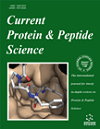- Home
- A-Z Publications
- Current Protein and Peptide Science
- Previous Issues
- Volume 23, Issue 3, 2022
Current Protein and Peptide Science - Volume 23, Issue 3, 2022
Volume 23, Issue 3, 2022
-
-
Dephosphorylation Targeting Chimaera (DEPTAC): Targeting Tau Proteins in Tauopathies
More LessAuthors: Andrea Soumbasis, Mohamed A. Eldeeb, Mohamed A. Ragheb and Cornelia E. ZorcaOne salient hallmark of neurodegeneration is the accumulation of toxic protein aggregates in neuronal cells. This proteotoxicity culminates in the deterioration of neuronal function. In AD and related tauopathies, the microtubule-associated protein tau becomes hyperphosphorylated. Hyperphosphorylated tau forms neurofibrillary tangles (NFTs) within neurons, which constitute a unique feature of tauopathies, including Read More
-
-
-
Gasdermins: Pore-forming Proteins as a Potential Therapeutic Target
More LessAuthors: Kripa Jain, Kalyani Barve and Lokesh K. BhattGasdermins are novel pore forming proteins that comprise Gasdermin A, Gasdermin B, Gasdermin C, Gasdermin D, Gasdermin E and Pejvakin (DFNB59). Recently, pyroptosis has been redefined as "Gasdermin mediated necrosis", as gasdermins are key regulators of apoptosis, necrosis, and pyroptosis. The discovery of the gasdermin family has broadened the field of pyroptosis studies. Studies have correlated gasdermins wit Read More
-
-
-
Cannabinoids as Potential Molecules for Addiction Disorders
More LessAuthors: Virna M. Martín Giménez, Luciana Mazzei, Raúl Sanz and Walter ManuchaBackground: Addictions are a group of chronic and recurrent diseases of the brain characterized by a pathological search for reward or relief through the use of a substance or other action. This situation implies an inability to control behavior, difficulty in permanent abstinence, a compelling desire to consume, decreased recognition of significant problems caused by behavior and interpersonal relationships, and a Read More
-
-
-
Protein Structure Readouts of Cancer Drivers for Precision Medicine
More LessAuthors: Jaspreet K. Dhanjal and Rajkumar Singh KalraCancer is fundamentally a disease of perturbed genes. Although many mutations can be marked in the genome of cancer or a transformed cell, the initiation and progression are driven by only a few mutational events, viz., driver mutations that progressively govern and execute the functional impacts. The driver mutations are thus believed to dictate and dysregulate the subsequent cellular proliferative function/decis Read More
-
-
-
COVID-19 and L-arginine Supplementations: Yet to Find the Missed Key
More LessCurrent coronavirus disease (COVID-19) is regarded as a primary respiratory and vascular disease leading to acute lung injury (ALI), acute respiratory distress syndrome (ARDS), and endothelial dysfunction (ED) in severe cases. The causative virus of COVID-19 is SARS-CoV-2, which binds angiotensin-converting enzyme 2 (ACE2) for its entry. It has been shown that ED is linked to various COVID-19 complications since Read More
-
-
-
A Review: Molecular Mechanism of Regulation of ABCA1 Expression
More LessAuthors: Dongdong Wang, Andy W. K. Yeung and Atanas G. AtanasovATP-binding cassette subfamily A member 1 (ABCA1) protein plays an essential role in a variety of events, such as cholesterol and phospholipid efflux, nascent high-density lipoprotein (HDL) biosynthesis, phospholipid translocation. Thus, there has been much research activity aimed at understanding the molecular mechanisms of regulating ABCA1 expression. In this review, we first discuss ABCA1 structure, tissue distrib Read More
-
-
-
On the Potential Significance of the Intrinsically Disordered Regions in the Clostridiodes difficile Toxins A and B
More LessAuthors: Nashwa El Hadidy, Vladimir N. Uversky and Xingmin SunBackground: Clostridiodes (or Clostridium) difficile is a spore-forming, Gram-positive anaerobic bacterium that may cause symptoms ranging from diarrhea to pseudomembranous colitis. During the C. difficile infection (CDI), the two primary bacterial toxins, toxin A (TcdA) or toxin B (TcdB), disrupt host cell function mainly through the inactivation of small GTPases that regulate the actin cytoskeleton. Both toxins have comple Read More
-
Volumes & issues
-
Volume 26 (2025)
-
Volume 25 (2024)
-
Volume 24 (2023)
-
Volume 23 (2022)
-
Volume 22 (2021)
-
Volume 21 (2020)
-
Volume 20 (2019)
-
Volume 19 (2018)
-
Volume 18 (2017)
-
Volume 17 (2016)
-
Volume 16 (2015)
-
Volume 15 (2014)
-
Volume 14 (2013)
-
Volume 13 (2012)
-
Volume 12 (2011)
-
Volume 11 (2010)
-
Volume 10 (2009)
-
Volume 9 (2008)
-
Volume 8 (2007)
-
Volume 7 (2006)
-
Volume 6 (2005)
-
Volume 5 (2004)
-
Volume 4 (2003)
-
Volume 3 (2002)
-
Volume 2 (2001)
-
Volume 1 (2000)
Most Read This Month
Article
content/journals/cpps
Journal
10
5
false
en


